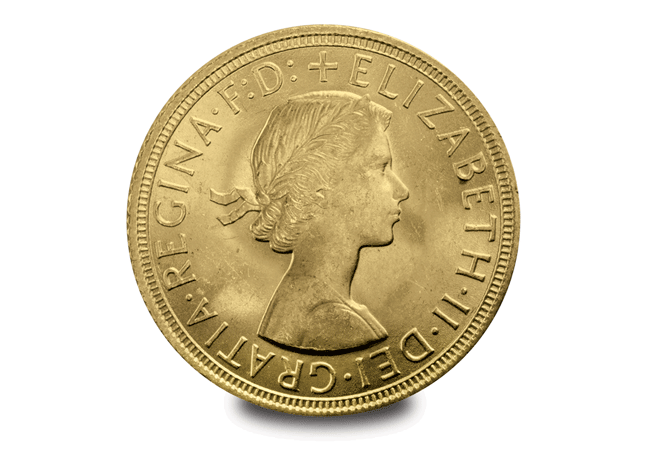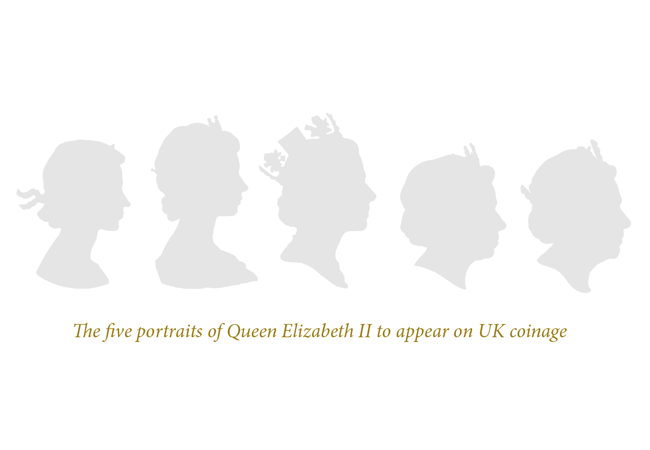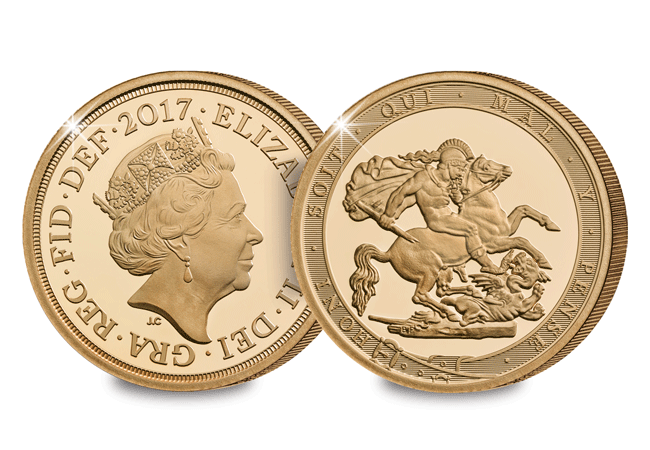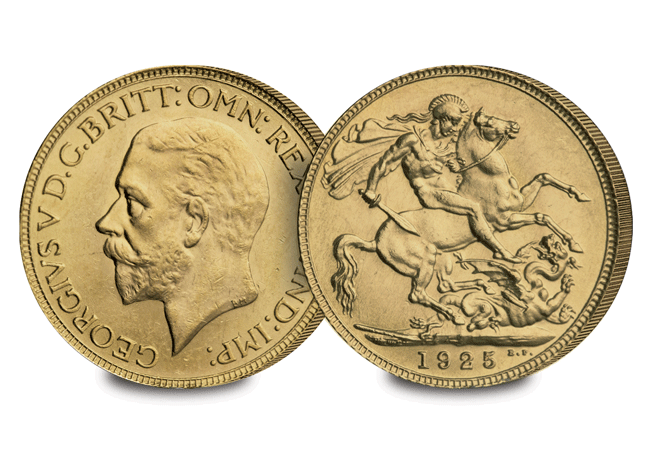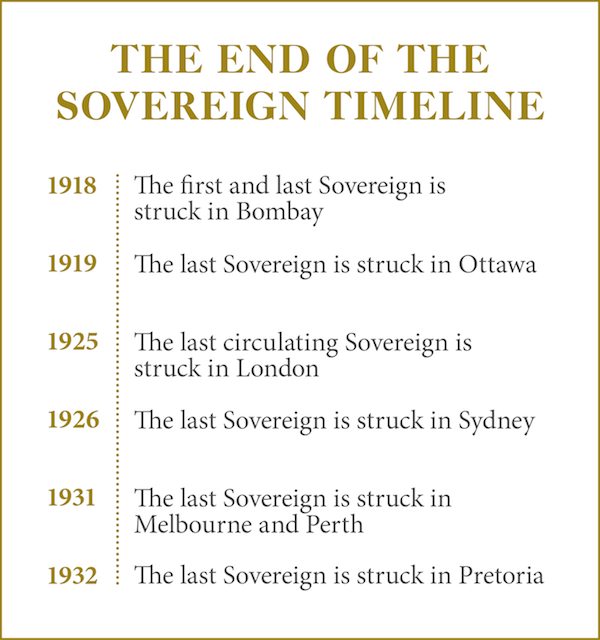Posts Tagged ‘UK Coin’
200 years of the Sovereign. Part VI: The UK’s Premier Gold Coin

2017 sees the Gold Sovereign’s bicentenary, and to mark the occasion a special one-year-only design has been unveiled, recreating Pistrucci’s original 1817 engraving. It’s a truly fitting tribute and acknowledges the rich history of the coin which I’ve been exploring in these blogs. If you missed the previous posts you can start from the beginning here, but now here’s the final chapter in the sovereign’s history so far…
In Part V, I explored the decline in production of Gold Sovereigns as a result of World War I and the worldwide economic crisis, which lead to the end of the Sovereign. Until 1957 when it was revived once again…
Apart from one special limited edition commemorative issue for King George VI’s coronation in 1937, no Sovereigns had been struck since 1932. In 1953, Sovereigns were produced for Queen Elizabeth II for the Coronation Sets but they were for national collections, not collectors.
The Sovereign’s revival
Then in 1957, worldwide demand for the coins became so great that The Royal Mint resumed production of bullion gold Sovereigns for circulation. Not only would this satisfy demand, it would also blunt the premium that was making it so lucrative to counterfeit the coins.
These early ‘restoration’ Sovereigns of Queen Elizabeth II’s reign feature Mary Gillick’s portrait of the young Queen on the obverse, engraved especially for her new coinage.
The portrait design was changed in 1968 prior to Decimalisation in 1971, to a portrait by Arnold Machin. This portrait still features on postage stamps all these years later.
A new market emerges
Queen Elizabeth II’s reign has been a time of change for the Sovereign. A new market has emerged – the collector’s market.
In 1979, The Royal Mint produced the first proof version of the Sovereign of her reign. This higher grade version was limited to just 12,500 pieces and proved very popular with collectors.
With a newfound interest from collectors, it is not surprising that we have seen more design variations of the Sovereign than ever before.
A third portrait design by Raphael Maklouf was used from 1985 to 1997 and a fourth by Ian Rank-Broadley FRBS replaced this until 2015 when Her Majesty’s portrait was updated by The Royal Mint engraver, Jody Clark.
The UK’s Premier Gold Coin
We have also seen the introduction of commemorative one-year-only designs, which started in 1989 with the issue of a special 500th anniversary Sovereign, featuring a design similar to the first Sovereign in 1489. These special commemorative designs have become more and more popular.
Since then, there have been one-year-only designs for the Queen’s Golden Jubilee in 2002, the modern St. George and the Dragon in 2005, the Diamond Jubilee in 2012 and the Queen’s 90th birthday in 2016.
These limited editions have seen a surge in Sovereign collecting, cementing its position as the UK’s premier gold coin.
It’s universal appeal shows no sign of slowing. In recent financial crises, people all over the world clamoured for Gold Sovereigns.
The Sovereign’s reputation for quality and reliability remains and will remain for years to come and now the next chapter in the Sovereign story has been written…
Announcing the new UK Bicentenary Gold Proof Sovereign
To mark the Bicentenary of the “modern” Gold Sovereign in 2017, The Royal Mint have just released a brand new Gold Proof Sovereign reprising Benedetto Pistrucci’s original engraving from 1817.
With a low edition limit of just 10,500 worldwide, a special one-year-only design change and a fine proof finish, the 2017 Bicentenary Gold Sovereign has all the elements to be one of the most collectable British gold coins of the 21st century. And now you can own one.
200 years of the Sovereign. Part V: The End of the Sovereign…
In my last blog post, I explored the Gold Sovereign’s incredible success as the most trusted and popular of all gold circulating coins throughout the world during the Empire years until 1931 when its reign as the King of Coins came under threat…
The Outbreak of the First World War in 1914, followed by the worldwide economic crisis in 1931 seemed to sound the death-knell for the Sovereign.
Gold Sovereigns were struck annually until 1915, but production dropped dramatically in 1914 and the majority of the 20 million minted in 1915 were for overseas use.
Decline in Production
As part of the emergency measures put in place upon the Outbreak of the First World War, specie payments were suspended and Treasury notes replaced gold. Gold coins disappeared from circulation but they continued to be minted for overseas bullion transactions.
Sovereigns were struck in 1916 and a small amount in 1917, but no more circulating Sovereigns were minted in London, except for a consignment for overseas use in 1925. The overseas branch mints still struck considerable quantities of Sovereigns.
Sovereign production continued after the war, but in much smaller numbers. Despite this, another two branch mints were opened. One in Bombay in 1918, which struck Sovereigns for just one year only. The other was opened in South Africa in 1923.
By 1926, only three branch mints were still operating – Perth, Melbourne and Pretoria. However, the worldwide economic crisis in 1931 signalled the end of these remaining branch mints, Britain left the Gold standard and the last Sovereigns were struck in Pretoria in 1932.
This appeared to be the end of the Sovereign. But all was not as it seemed.
Would the Sovereign be revived again?
Find out in the final part of our 200 years of the Sovereign Blog Series – click here to read it >>
Announcing the new UK Bicentenary Gold Proof Sovereign
To mark the Bicentenary of the “modern” Gold Sovereign in 2017, The Royal Mint have just released a brand new Gold Proof Sovereignreprising Benedetto Pistrucci’s original engraving from 1817.
With a low edition limit of just 10,500 worldwide, a special one-year-only design change and a fine proof finish, the 2017 Bicentenary Gold Sovereign has all the elements to be one of the most collectable British gold coins of the 21st century. And now you can own one.
200 years of the Sovereign. Part IV: The Empire Years…
In Part III, I explored the history of Benedetto Pistrucci’s timeless St. George and the Dragon design used on the Gold Sovereign until its exile in 1825. But that wasn’t the end. It was revived nearly 50 years later in 1871…
The Gold Sovereign reached the height of its prominence and prestige under the record-breaking reign of Queen Victoria as the British Empire expanded.
The ‘chief coin of the world’
The Gold Sovereign was legal tender in 36 colonies during the 1860s and was widely used in countries with no allegiance to the British crown which prompted leading British economic historian, Sir John Clapham to name it ‘chief coin of the world’.
What you may not realise is that not all of these coins were struck in Britain. Sovereigns were struck in many dominions of the British Empire.
International Production
Between 1871 and 1932, Sovereign production was spread over four continents outside of Europe: North America, Australia, Africa and Asia, with branches of The Royal Mint in a number of major international cities.
In order to distinguish where the Sovereigns were minted, The Royal Mint used a variety of mint marks.
These were either a letter or several letters to show its origin. They are found on the coin’s reverse, above the inner two numbers of the date.
Mintmarks from across the World
AUSTRALIA – Gold was discovered in New South Wales in 1851 and three branch mints opened in Sydney, Melbourne and Perth. The mintmarks here bore the initial of the city they were manufactured in.
SOUTH AFRICA – the African Sovereign is identified by its initials ‘SA (South Africa) and was struck in Pretoria.
CANADA – Despite experiencing its first gold rushes earlier than Australia, a branch mint did not open in Canada until 1908. Sovereigns produced in Canada were marked with a ‘C’ signifying its Canadian origin. The Canadian Sovereign almost certainly contains gold from the Yukon.
INDIA – Sovereigns struck in India are identified by the country’s initial ‘I’. Sovereigns here were only produced during the year 1918, so they are particularly rare and a target for collectors.
During the reign of King George V, the British Empire reached its territorial peak. It had risen to become the largest formal empire the world had ever seen, holding sway of over 25% of the globe’s population and landmass.
The Gold Sovereign emulated the success of the Empire – it was the go-to coin for international trade. The Sovereign was the most trusted and popular of all gold coins circulating throughout the world.
But its reign as the King of Coins came under threat. The outbreak of World War I in 1914 and the economic crisis in 1931 seemed to put the Sovereign’s future into jeopardy. Was this the end?
Find out in Part V of our 200 years of the Sovereign Blog Series – click here to read >>
Announcing the new UK Bicentenary Gold Proof Sovereign
To mark the Bicentenary of the “modern” Gold Sovereign in 2017, The Royal Mint have just released a brand new Gold Proof Sovereign reprising Benedetto Pistrucci’s original engraving from 1817.
With a low edition limit of just 10,500 worldwide, a special one-year-only design change and a fine proof finish, the 2017 Bicentenary Gold Sovereign has all the elements to be one of the most collectable British gold coins of the 21st century. And now you can own one.
Click here to secure yours today >>

